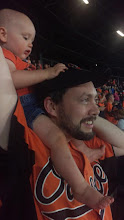
As you're looking at this nearly fifty-year-old card, the first thing that jumps out at you is likely the ornate trophy icon that stretches from
Ron Hansen's hips to his wrists. Since 1959, Topps has selected an All-Star Rookie team. The awesome logo you see above appeared on cards for the honored young players from 1960-1972. In 1973, they switched to a simple gold cup commonly known as the "Rookie Cup"; this design appeared on cards that year and again from 1975-1978, and finally from 1987 on through to the current day. I've always enjoyed seeing that designation on a card; it's visually appealing and it feels a little special. When I got back into collecting in 2007, my first purchase was that year's Series 1 Topps Orioles team set. I was proud to see the Rookie Cup on
Nick Markakis' card; it was like a form of validation that the promising young outfielder had truly arrived.
Topps picks the top rookie at each position (there's no DH but there is both a LHP and a RHP, and there are 3 OFs just like the Gold Gloves). Some choices are a slam dunk, like Hansen. He hit 22 home runs and drove in 86 as a shortstop, which was rarefied air in those days. Not only was he the American League's Rookie of the Year, but he finished fifth in MVP balloting. Other times, Topps had to select from a shallow pool. I did a double take when I saw the Rookie Cup on
Geronimo Gil's 2003 card (2002 stats: .232 AVG, .277 OBP, 12 HR. 45 RBI), for instance.
Earlier this week, Topps announced their latest All-Star Rookie Team. Though the O's crop of budding young players had been shut out of the Rookie of the Year voting, they were represented on this team by outfielder
Nolan Reimold, who hit .279 and led all A. L. rookies in home runs (15), on-base percentage (.365), and slugging percentage (.466). But the real news was the exclusion of much-heralded rookie catcher
Matt Wieters, who was apparently passed over in favor of 28-year-old former Oriole and current Met receiver
Omir Santos. Their stats (both played in 96 games):
Wieters: .288/.340/.412, 15 2B, 9 HR, 43 RBI
Santos: .260/.296/.391, 14 2B, 7 HR, 40 RBI
So what's the deal? Was Topps suffering from New York Bias? Were they committing blasphemy? Did they deem themselves unworthy of so much as uttering the name of the Great Wieters? Not quite. As near as I can tell, this bizarre selection was the result of good old fashioned baseball card company politics.
Last year, Razor (a smaller-time company that focuses on autographs and memorabilia and specializes in minor league and amateur players)
trumpeted the signing of Wieters to an "exclusive" contract. Since Upper Deck has an agreement with the MLB Players' Association, however, they would have the right to produce cards of the catcher as soon as he was called up to the Orioles' big league roster (i.e., May 29, 2009). Topps' license is with the MLB itself, and not the players' association, so they're apparently shut out from the Wieters Derby until 365 days after his MLB debut; you won't see any Topps cards of the ex-Yellow Jacket until after Memorial Day 2010. I can barely make sense of the particulars here, but Razor basically wanted to boast that they would have Matt "first". Ugh.
So there you have it; Matt Wieters signed the deal with Razor ---> Topps can't feature him in their 2010 Series 1 ---> Topps chooses the path of least resistance and goes with a less-impressive catcher on their All-Star Rookie team. I'm sure Wieters will take solace in the MVP, Gold Glove, Silver Slugger, All-Star MVP, and World Series MVP trophies that he'll collect in 2010. No pressure, bud.
 Sometimes, Monday rolls around after a long and fulfilling holiday weekend and you wonder how you'll ever get back into the grind. It's dark, it's rainy, you're drawing a blank on Christmas gift ideas, and you know that you should squeeze in a workout but you just don't feel like it.
Sometimes, Monday rolls around after a long and fulfilling holiday weekend and you wonder how you'll ever get back into the grind. It's dark, it's rainy, you're drawing a blank on Christmas gift ideas, and you know that you should squeeze in a workout but you just don't feel like it.





























